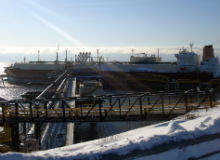
Canaport LNG started the construction of a state-of-the-art Liquefied Natural Gas (LNG) receiving and regasification terminal in St John, New Brunswick in late 2006 (initial work, such as site clearance, was completed in May 2005).
Canaport LNG is a Canadian-based joint energy project owned by Repsol YPF and Irving Oil. The project began operations in second quarter of 2009 and is the first LNG regasification plant in Canada.
The plant supplies natural gas to the domestic Canadian and American markets. The initial distribution capacity of the terminal is 28 million cubic metres (one billion cubic feet) of natural gas a day (1bcf/d, or approximately 10 billion cubic metres annually (bcma)), with a peak capacity of 1.2bcf/d, which will be expandable to 2bcf/d when the market is ready for additional natural gas supplies.
The Canaport LNG project is estimated to have cost C$756m. Repsol YPF completed its agreements in early 2007 to transport natural gas from the Canaport LNG Terminal to markets in Canada and the Northeast US via the Brunswick Pipeline and an expansion of the Maritimes and Northeast Pipeline system in the US. The 145km Brunswick Pipeline was completed in 2009.
Construction and contractors
Canaport LNG has awarded the construction contract to SNC-CENMC GP, a partnership between SNC-Lavalin of Montreal, Quebec, and Saipem SpA of Milan, Italy, and Kiewit-Weeks-Sandwell Partnership, a consortium of Peter Kiewit Sons Co of St John’s, Newfoundland, Weeks Marine of Cranford, New Jersey and Sandwell Engineering of Vancouver, British Columbia.
Canaport LNG terminal was completed in June 2009. The LNG storage tank, which Canaport announced in September 2007, was completed in April 2010. The third tank has a capacity of 160,000 cubic meters.
Fabrication contracts
In October 2006 Lorneville Mechanical Contractors (LMC) of St John was awarded a significant contract to construct the steel interior and roofs of two LNG storage tanks at the terminal. In August 2006 another contract was awarded to OPRON of St John to complete the concrete exterior of the LNG tanks.
Modern LNG tanks require highly specialised materials and extremely sophisticated engineering construction techniques. The tanks are double-walled with highly efficient insulation between the walls to keep the stored natural gas in a liquid state for safe and efficient handling. The tanks maintain extremely cold temperatures of at least -161.5°C.
Docking of tankers
The Canaport LNG project is located adjacent to the Irving Oils’ refinery at St John. Because the LNG unloading pier is fixed, ships can unload LNG and crude oil at the same time.
All ships brought into Canaport LNG for unloading, whether at the monobuoy (where crude oil is unloaded), or at a pier, are brought in based on weather conditions. The pier is built to withstand worst-case scenario weather, and ships are brought to the pier only when the weather allows.
Pipeline route
The LNG regasification plant supplies a new pipeline connected to the Canadian natural gas grid.
The new natural gas pipeline runs underground through the industrial corridor already in place at Rockwood Park, the site of high-tension electrical power lines. This was chosen because it presented the least amount of risk to the community or to the environment.
Running an underwater pipeline across the St John harbour presented a greater degree of long-term risk and environmental impact to the St John area so this was rejected.



